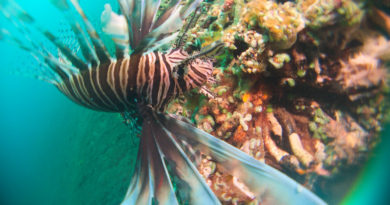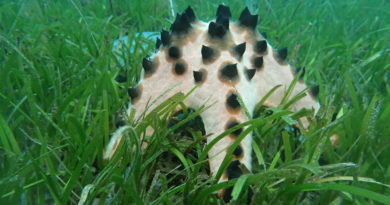Invasive Species – Mosquitofish
I have recently written about invasive species, and how islands are particularly vulnerable to these. In the last months in the Philippines, the North American “mosquito fish” were used to contain mosquitoes, which are vectors for the Dengue virus. Dengue causes high fevers, and can be deadly in already weakened patients, like children or old people. I am sure this was done with good intentions, and the Dengue problem is a very serious and urgent one. This is not a blog post about the politics of these species introductions, but about the biology of invasive species:
Why Bring in New Species?
Of the many invasive species which have gotten a foothold in lands far away from where they naturally occur, some have been accidentally introduced, and some on purpose, by government agencies. Sometimes this was for mere entertainment, such as in the case of the foxes released in Australia, which the Anglo folks who had settled there felt like hunting. Jolly bad idea, lads!
In other cases, the invaders were brought in from a different part of the world to fulfill a certain function. The famous cane toads were brought to Australia to eat the sugar cane beetle, which it ironically did not do very well.
The aforementioned mosquito fish (a freshwater fish originally from North America) is frequently transplanted to feed on mosquitoes, and to control mosquito-borne diseases. This has worked in some areas, like in the south of Russia. However, in contrast it has done little good and has done considerable damage to the native ecosystem in Australia, where it is now classified as a pest. As I have mentioned before, due to it’s remote location and distinct fauna, the continent often behaves like an island when it comes to species invasions, and has been hit particularly hard. That islands and Australia – as a super island – are hit hard by species invasions has historically been the case. Generally, though, it is hard to predict which ecosystems are susceptible, what effect an introduced species will have, and introductions often turn out detrimental.
Bad Idea
The damage done by invasive species might not be immediately obvious to the casual observer.
Invasive species often out-compete native species. They might reproduce faster, or not be eaten by native predators, hence their populations will rise fast. They might eat the food of the natives; They might have a higher tolerance for environmental parameters, like the salinity of the water (being able to live in fresh- and brackish water, for instance). They might also directly feed on native species. In all these cases, the result will be an ecosystem with fewer or none of the native species in it, and a lot of the invaders. In many cases, the invasive species spread fast, and even small fishes can cross boundaries between different bodies of water; this can happen in a couple of different ways, simply accidentally transferring a few tiny eggs in a small volume of water will allow the fish to invade a new pond, lake, creek or river.
You have to look pretty closely to observe that small fishes are mean to each other; nevertheless the results can be dramatic for native species, up to extinction. The damage might not be visible to someone just glancing at a lake from above, but the structure of the ecosystem of the lake might be already fairly messed up.
In a study of the interactions between invasive mosquito fish and native chubs in Utah in the US, fish scientists noted a number of different negative effects of the mosquito fish on the chubs. In fish tanks, the mosquito fish ate almost 70% of the juvenile chubs in only three hours. In their natural environment, chub juveniles were less aggressive, hid more and were more stationary in the presence of mosquito fish, likely impeding their ability to forage. Native species facing bio-inavders can often compensate to counter one problem caused by the invasive species; It is the synergistic effect of several problems which eliminates them from their native habitat (see: Mills, M. D., Rader, R. B., & Belk, M. C. (2004). Complex interactions between native and invasive fish: the simultaneous effects of multiple negative interactions. Oecologia, 141(4), 713-721. ). This – the elimination of the native chubs – is what has already happened in large parts of their original range in Utah.
Why is that even Bad?
An ecosystem is more stable the more diverse it is. If more than one species fill a role in an ecosystem, a permanent or temporary elimination of a single species will have less of a detrimental effect on the ecosystem as a whole. If one quickly reproducing fish eliminates a number of competing native fishes and invertebrates, the ecosystem becomes poorer, and more fragile.
Species fulfill functions in an ecosystem – that does not mean that they were put there, on purpose, by some creator, but it means that over the course of evolution, possibly millions of year, an equilibrium had been reached between species. Co-evolution between species has happened, like insects pollinating flowering plants or birds dispersing seeds. Small fish might play a role which we don’t even understand yet, such as feeding on the parasites of larger fish. Any elimination of a species from an ecosystem is a loss, some of these losses might be costly for the ecosystem as a whole; which ones are the costly ones is hard to predict.
Finely tuned ecosystem processes get out of sync when an invasive species takes over.
Also, native, often endemic species (only occurring in one part of the world, or even only on one island) are of an enormous intrinsic value. These are animals or plants which had evolved over millions of year. An invasive species eliminating them is a loss which will take many human life-times to replace, and it will not be replaced in the same manner. Even if the lost species have no economic value, their intrinsic value is priceless.
Coming next: The few cases were invasive species were successfully eliminated again after they were introduced.

